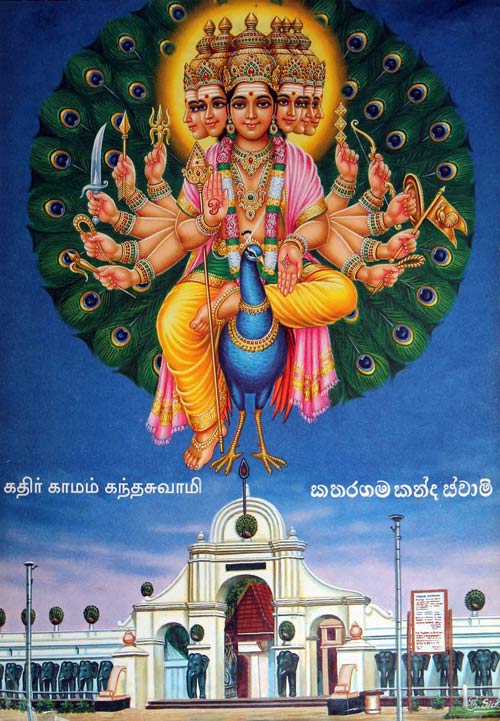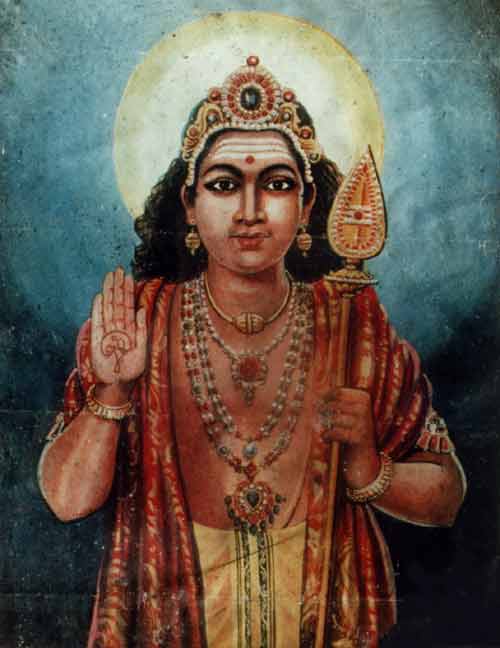
|
|||||||||
|
| |||||||||
The Kataragama God: Shrines and Legendsby H.E. Ameresekere, M.R.A,S., C.B. (Retired Mudaliyar, M.P.)
|

|
1935 archival photo (left to right): Ganapati Kovil, Maha Devale, Teyvani Amman Kovil gate |
 |
 |
Kataragama Deviyo is the Hindu war-god, at whose shrine at Kataragama, in the South-West coast of the Island, thousands of pilgrims from all parts of India and Ceylon congregate annually for worship. Among them are fakirs from India clad in a breech-clout with bodies smeared with ashes and hair matted or coiled on the head or falling over the shoulder.
There is no written account ancient or modem, nor any clear legendary lore regarding this deity. He is invested with all the attributes of Skanda, the Hindu god of war, who is said to have sprung from Siva, the third deity of the Trimurti, in a miraculous manner and to have destroyed the mighty and wicked Titan, named Suran or Padura, of the Asuras, The date of this event is beyond historical computation. It is long anterior to the twelve years' war of Rama with Ravana, which according to the Rajavaliya took place circa 2387 BC.
A critical examination of the Sinhalese at and Tamil accounts leads one to the belief, though there will be thousands of his votaries to assail the statement, that the Kataragama Deviyo of the Sinhalese and Kandaswami of the Tamils, was a king who reigned at one time at Kataragama and was subsequently deified as an incarnation of the Puranic Skanda.
The Sinhalese poet, Sri Rahula, while enjoining the adoration of this deified king, refers to his heroic victory as follows:
Dit rada
pinisa sara piyumai namati lola
Gat siya atin
kotinana mera siduru kala
Gat teda rasev
Mahasen devradunudula
Sit sahatosin
namaduva denuve manadola 1
"With joyous
mind bow down and offer the tribute of your heart
to the god-king Mahasen,
refulgent in the blaze of glory
acquired what time he seized the spear against
the Titan king Padura Asura,
and piercing him transcended (Mount) Meru."
According to Buddhist annals King Mahasen was at Kataragama when Buddha visited the place on his last visit to Ceylon circa 569 B.C.; and according to a Tamil tradition recorded in the Yalpana Vaipara Malai, Vijaya, who became king about 543 BC. built a temple for ‘Kadirai Andavar’. We may therefore assume that this god-king reigned at Kataragama circa 569-543 BC.
Kataragama is known in Tamil as Kadiraimalai, and it is referred to in Kailaya Malai as follows:
Varintha Silai
Vedar kula mathu
punar Velantha Karan Sen
Kadan puthalvan
Kathirkaman eda vilun
Tharkkadamban per
Murugan Dhamodaran Murugan
Serkakuravan Devar
theradkoruvan Soorpyakaiyu
Mathunkulan Kulakan
Vamtha adiyar thuyarai
Tattu
kumararanulala pothu Devar
Vaintha Kaderamalai
"Kadirai Malai
sacred to the carrier of the lance,
the husband of the bow-armed Veddah maid,
the son of Senkadan (Siva) Kadirgaman,
the wearer of the wreath of Kadamba
flowers,
Murugan, the nephew of Damodaran (Vishnu) the able chief,
the leader
of the celestial forces, the destroyer of the Asura enemies,
Kugan, Kulagan,
Kumaran, who takes away the troubles of his devotees --
Kadiramalai, where he
dispenses his grace and where he is worshipped."
The god is known by a great many names. By the Sinhalese, he is called Dev Senevi, Kumar, Kanda, Mahasen, Bara-ath, Kotha-uda; and by the Tamils, Kumaran, Kandaswami, Kandan, Kadiraman, Arumukan, Kugan, Kulagan, etc. According to Sinhalese legends handed down for generations, Kataragama Deviyo was a prince who came from Kosala in a gal-poruwa (granite raft) and landed at Dewinuwara [Dondra]. After a short stay he left the place and took his abode on the mountain peak afterwards called Vedahitiya Kanda, near Kataragama.
Like Lakshaman of Adams Peak, Vibhusana of Kelaniya, this prince, whose Indian name has been lost in the passage of time, was deified and became the tutelar deity of certain parts of the Island; but of these places, the Hindus and Buddhists, by a mutual toleration, agree that Kataragama is the most sacred spot dedicated to this most dreaded of all guardian deities.
This warrior prince, who is called Kumar in the story that follows, is said to have been married in India to one Thevani Amma (Teyvayanai, Devasena). Being a reputed huntsman he in the course of one of his excursions in the new settlement, came across a beautiful damsel in a thana-hena (chena grown with the millet thana), and sought to make her his second consort. This he obtained by a stratagem. She is known by the name of Valli Amma, and was the daughter of a pandaram or hermit and a doe, and had been brought up by a Veddah chief. Though Kumar fell in love with her, she would not respond to his advances. Learning, however, in the course of conversation that the only thing she dreaded was the elephant, Kumar apprised his brother Ganapati of his love. Ganapati proferred his assistance in the form of an elephant giving the brother an opportunity of succouring her. Before assuming that form however, he gave his brother a pot of water to be poured on him when the stratagem succeeded so that he may might regain his usual form.
Kumar went to meet the damsel in the guise of a hermit and found her partaking of a meal of thana which was choking her throat. Kumar gave her a drink of water from the pot and in his eagerness spilt all the contents of the pot. At this juncture Ganapati appeared as an elephant and the girl appealed to the hermit for help. He consented to do so if she would come with him, which she agreed to do. When they came to Kataragama, Ganapati appeared also but as Kumar had spilt the contents of the pot the brother had to remain ever afterwards in that form, with a human body and an elephant's head.
The Veddah chief set out with all his retinue in search of his missing foster child and finding her with Kumar at Kataragama gave battle but was killed with all his men. The maiden was greatly grieved, whereupon to please her Kumar recalled them all to life.
Restored from Yama's dark domain
The Veddah legion filled the plain,
And round the royal prince arrayed
Their low obeisance paid.
Kumar thus proclaimed King made Valli Amma his consort, and in course of time Thevani Amma also came from India with a number of Brahmin attendants and settled down at Kataragama.
History of the Shrine
The first Sinhalese king associated with Kataragama after Vijaya is Devanampiyatissa. He caused a sapling of the Bo-tree brought by Sanghamitta to be planted at Kataragama (Mv. xix) because it was a spot hallowed by Gautama on his last visit to Ceylon. In the reign of this king members of the royal family seem to have been resident at Kataragama, for the Mahavansa tells us that "princes from Kajaragama assembled" at the ceremonial planting of the Bo-tree at Anuradhapura. According to tradition a sub-king named Dasaba ruled there.
[In] 661 AD Aggabodi, chief of Ruhuna, son of Mahatissa of the Okkala race "built a vihara and a house for monks at Kajaragama." “He added new buildings to the Dhammasala vehera and granted the village Mandagama to the monks" (Mv xiv 38-46). About the same time Sami Dapula, chief of Ruhuna "built Khadirali vihara where he made offerings to the gods” (Ib. 49. 55.)
1059. Kataragama was the capital of King Lokeswara (Mv lvii) and subsequently of Kesadhatu, Governor of Ruhuna and of Prince Kitti (Ib 74, 75) who became King under the name of Vijaya Bahu I. In his reign the general of the king of Chola, who was at Pollonnaruwa , invaded and laid the city waste " (Mv, lvii 6).
[to be continued]
1. Paravi Sandesa 42.
| Living Heritage Trust ©2019 All Rights Reserved |